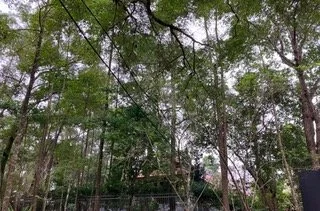Photo above taken by Magda Cabrero, of Thay’s Root Temple, Tu Hieu.
These are the trees right in front of his hut where his ashes have just been deposited.
Painting below at Thay’s museum near the Root Temple. It belonged to him.
Monday, May 13, we will meet online.
Dear friends,
This week: we will meet Monday from 7-8:30PM EDT online, Wednesday morning from 7-8AM EDT in person at our meditation space (3812 Northampton Street NW), and Friday 12-1PM EDT online.
On Monday night, Magda will facilitate. She will explore the insights of non-duality and interbeing based on her recent experience visiting Thich Nhat Hanh’s (Thay’s) Root Temple in Vietnam, Tú Hiéu, where Thay became ordained as a young man and returned near the time of his continuation. Magda will give the first of a series of sharings on the topic. She will also share some photos she took at the monastery.
During my recent visit to Tú Hiéu Monastery in Vietnam, I had the opportunity to attend ceremonies honoring Thich Nhat Hanh as an ancestral teacher. The events began with the Great Compassionate Offering Ceremony to All Living Beings with chanting that went on for a long time as the monastics and guests stood reverently with their hands in lotus position. The altar was beautifully decorated with yellow flowers and offerings of grapefruit. There were tables on both ends brimming with food that would be offered to everyone when the ceremony ended. I was moved by how, in a ceremony for a man who has done so much for humanity, Thay was treated as just one among myriad beings. I reflected on the dedication of merit that always closes my sangha gatherings: “May all beings be free from suffering and the root causes of suffering.” I remembered how, when I first heard these words, I wondered about the reference to “all” beings. I thought that it was unrealistic to help and care for everyone.
After the opening ritual I pondered the origins of this ancient reverence for myriad beings. I thought about the concept of the Tao: the fundamental unifying principle of the universe, composed of the varied forms and phenomena that Laotzu referred to as the “10,000 things” or wanwu. Zhuangzi, also a Taoist, understood that, for the spiritual path to be complete, humans need to empty themselves of egotism. Each of the wanwu contains a vital energy, a Qi or Chi, that links us all.
Other ancient philosophies such as Confucianism in China and Jainism in India came to mind. The Confucian Golden Rule is an ethic that was initially limited to humanity and adapted to respond to the challenge of Chinese Buddhism. Confucian classical texts came to incorporate the Buddhist insight that humanity and the entire natural world are inextricably connected. This recognition of a life force that dwells in everything brings a profound empathy with all beings. In the religions of India, this empathy is expressed through the principle of ahimsa, or do no harm, a principle upheld with unique commitment by the Jains.
In Buddhism, the doctrine of anatta (in Pali) or anatman (in Sanskrit) holds that there is no permanent, underlying substance that can be called the soul or the self. The notion of the self and the idea of separateness are only illusions. In our path towards Buddhahood, we are meant to keep moving forward, as though traveling through concentric circles, with an open and loving heart. Each circle’s rim represents mindfulness as the grounding principle.
I have always been drawn to the concept of the labyrinth, of returning to one’s center, but the concept of concentric circles might be even more powerful. It helps me visualize my path as one that takes me away from the illusion that my self is separate from the rest. It involves a kind of progressive embrace of the whole cosmos.
ONE WITH THE 10,000 NATURAL THINGS
My visit to Tú Hiéu added concentric circles to my spiritual journey. From the moment I stepped into that magical space, I did my best to eliminate all of my filters. I was in total silent receptiveness to the 10,000 natural things around me. I felt as if all of nature’s elements had become the Great Bell. As I breathed in, I took in all of Thay’s natural sanctuary. As I breathed out, I tried to empty myself of my ego, leaving more space to take in the beings around me: the soil, the rocks, the grass, the Half Moon pond, the birds, the bonsai and the ancient trees, and Thay’s beloved orange chrysanthemums. Qi links us all.
Sister Ðinh Nghiém led us to one of Thay’s favorite areas, near the grounds where he used to tend the cattle. As we stood in a circle singing “I have arrived, I am home,” I felt the energy of the red soil under me like a magnet. I was indeed home, feeling as though I never wanted to leave. I took a pinecone to keep a piece of this sanctuary with me forever.
PLAYING WITH CAIRNS
On the day that Thay was about to be honored as an ancestral teacher, near where his ashes will lay permanently, I saw three girls building cairns with pebbles they picked up from the earth. I smiled. I imagined how much Thay would have loved seeing these children playing spiritual games with these compounds of earth elements, innocently rejoicing in the Qi that links us all.


